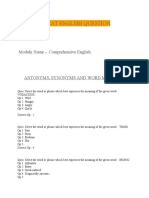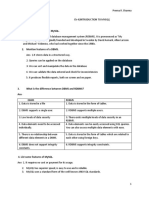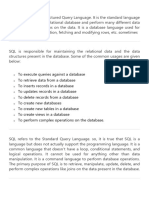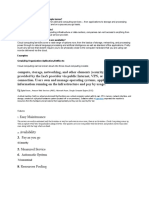Create Procedure AS Select From Where AND: 'London' 'WA1 1DP'
Uploaded by
Islamic IndiaCreate Procedure AS Select From Where AND: 'London' 'WA1 1DP'
Uploaded by
Islamic India1.Field is column in the table .
2.
Stored Procedure With Multiple Parameters
Setting up multiple parameters is very easy. Just list each parameter and
the data type separated by a comma as shown below.
The following SQL statement creates a stored procedure that selects
Customers from a particular City with a particular PostalCode from the
"Customers" table:
Example
CREATE PROCEDURE SelectAllCustomers @City nvarchar(30),
@PostalCode nvarchar(10)
AS
SELECT * FROM Customers WHERE City = @City AND PostalCode
= @PostalCode
GO;
Execute the stored procedure above as follows:
Example
EXEC SelectAllCustomers @City = 'London', @PostalCode = 'WA1
1DP';
3.
SQL UNIQUE Constraint
The UNIQUE constraint ensures that all values in a column are
different.
Both the UNIQUE and PRIMARY KEY constraints provide a guarantee
for uniqueness for a column or set of columns.
A PRIMARY KEY constraint automatically has a UNIQUE constraint.
However, you can have many UNIQUE constraints per table, but only
one PRIMARY KEY constraint per table.
INNER JOIN: The INNER JOIN keyword selects all rows from both the
tables as long as the condition satisfies
LEFT JOIN: This join returns all the rows of the table on the left side of
the join and matching rows for the table on the right side of join
FULL JOIN: FULL JOIN creates the result-set by combining result of
both LEFT JOIN and RIGHT JOIN. The result-set will contain all the
rows from both the tables. The rows for which there is no matching, the
result-set will contain NULL values.
KEY DIFFERENCE:
SQL is a language which is used to operate your database
whereas MySQL was one of the first open-source database
available in the market
SQL is used in the accessing, updating, and manipulation of data in
a database while MySQL is an RDBMS that allows keeping the
data that exists in a database organized
SQL is a Structured Query Language and MySQL is a RDBMS to
store, retrieve, modify and administrate a database.
SQL is a query language while MYSQL is a database software
PRIMARY KEY vs UNIQUE KEY
For an organization or a business, there are so many physical entities (such as
people, resources, machines, etc.) and virtual entities (their Tasks, transactions,
activities). Typically, business needs to record and process information of those
business entities. These business entities are identified within a whole business
domain by a Key.
As per RDBMS prospective, Key (a.k.a Candidate Key) is a value or set of values
that uniquely identifies an entity.
For a DB-Table, there are so many keys are exist and might be eligible for Primary
Key. So that all keys, primary key, unique key, etc are collectively called as
Candidate Key. However, DBA selected a key from candidate key for searching
records is called Primary key.
Difference between Primary Key and Unique key
1. Behavior: Primary Key is used to identify a row (record) in a table, whereas
Unique-key is to prevent duplicate values in a column (with the exception of a null
entry).
2. Indexing: By default SQL-engine creates Clustered Index on primary-key if not
exists and Non-Clustered Index on Unique-key.
3. Nullability: Primary key does not include Null values, whereas Unique-key can.
4. Existence: A table can have at most one primary key, but can have multiple
Unique-key.
5. Modifiability: You can’t change or delete primary values, but Unique-key
values can.
What is CLAUSE in SQL?
SQL clause helps to limit the result set by providing a condition to the query. A clause helps to filter the
rows from the entire set of records.
For example – WHERE, HAVING clause.
You might also like
- What Color Is Your Parachute? Job-Hunter's Workbook Tablet Edition10% (10)What Color Is Your Parachute? Job-Hunter's Workbook Tablet Edition3 pages
- Webrtc Android Client SDK API Reference GuideNo ratings yetWebrtc Android Client SDK API Reference Guide48 pages
- What Is Database?: You Can Download A PDF Version of SQL Interview QuestionsNo ratings yetWhat Is Database?: You Can Download A PDF Version of SQL Interview Questions34 pages
- Class XII-UNIT III - SQL and MySQL Notes_0 (1)No ratings yetClass XII-UNIT III - SQL and MySQL Notes_0 (1)6 pages
- 66 SQL Interview Questions Last Updated On Dec 19, 2022No ratings yet66 SQL Interview Questions Last Updated On Dec 19, 202234 pages
- Unit 3 DBMS Keys Join Aggregate View ClausesNo ratings yetUnit 3 DBMS Keys Join Aggregate View Clauses23 pages
- Union Union All: Unique Key in A Table Can Be Null Primary Key Can Not Be NullNo ratings yetUnion Union All: Unique Key in A Table Can Be Null Primary Key Can Not Be Null11 pages
- Viva Questions For SQL & Java For STD 12No ratings yetViva Questions For SQL & Java For STD 1220 pages
- Informatics Practices - Import Theory Question - SQLNo ratings yetInformatics Practices - Import Theory Question - SQL7 pages
- Class 12:DATABASES MANAGEMENT SYSTEM AND SQLNo ratings yetClass 12:DATABASES MANAGEMENT SYSTEM AND SQL9 pages
- Standalone Decision Master (Complete) .XLSX - 0No ratings yetStandalone Decision Master (Complete) .XLSX - 05 pages
- NON-Life - Omniscan Post Installation Configuration Manual For WorkflowNo ratings yetNON-Life - Omniscan Post Installation Configuration Manual For Workflow12 pages
- Ourse Notes Ogistic Egression: Course Notes: Descriptive Statistics Course Notes: Descriptive StatisticsNo ratings yetOurse Notes Ogistic Egression: Course Notes: Descriptive Statistics Course Notes: Descriptive Statistics6 pages
- Easy Maintenance: What Is Cloud Computing, in Simple Terms?No ratings yetEasy Maintenance: What Is Cloud Computing, in Simple Terms?8 pages
- Alexander Wright - Songwriting - How To Write Lyrics For Beginners (2016)No ratings yetAlexander Wright - Songwriting - How To Write Lyrics For Beginners (2016)30 pages
- Explain Option Available in Page Setup Group of Page Layout in MS-Excel 2007No ratings yetExplain Option Available in Page Setup Group of Page Layout in MS-Excel 20073 pages
- ASVIA - ENT Instrument For Policlinic Set: Pt. Asvia Laguna MedisNo ratings yetASVIA - ENT Instrument For Policlinic Set: Pt. Asvia Laguna Medis5 pages
- 7144?filename FP Flowerpot Amigurumi Pattern100% (10)7144?filename FP Flowerpot Amigurumi Pattern8 pages
- Made To Measure.: Practical Guide To Electrical Measurements in Low Voltage SwitchboardsNo ratings yetMade To Measure.: Practical Guide To Electrical Measurements in Low Voltage Switchboards72 pages
- RNA Sequence Structure and Function Computational and Bioinformatic Methods 1st Edition Jan Gorodkin - Download the entire ebook instantly and explore every detail100% (2)RNA Sequence Structure and Function Computational and Bioinformatic Methods 1st Edition Jan Gorodkin - Download the entire ebook instantly and explore every detail84 pages
- Debre Berhan University: College of Medicine and Health Science Department of Public Health Epidemiology100% (1)Debre Berhan University: College of Medicine and Health Science Department of Public Health Epidemiology41 pages
- STC-1000 Temperature Controller Operating Manual: or or orNo ratings yetSTC-1000 Temperature Controller Operating Manual: or or or1 page










































































































